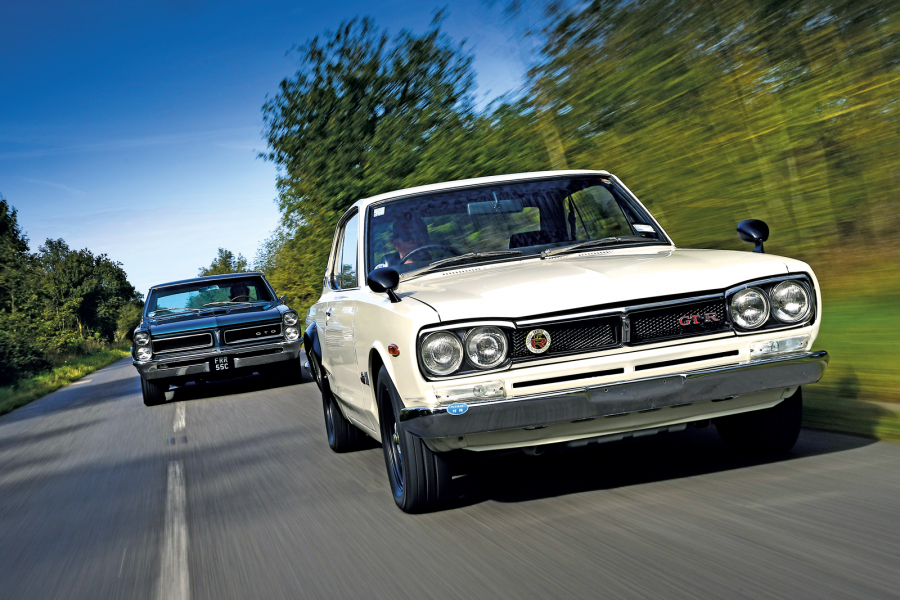It’s a bit puzzling how the Nissan still manages to feel a touch heavy.
In 200ZR form it has an identical weight to the Starion and, even as the longer-wheelbase 2+2, its dimensions aren’t wildly different.
Ultimately, it comes down to the chassis tuning of these cars and, even in this lightest, most sporty form, the ZR can’t fully escape the American angling of the Z31 platform.
Boastful badging on the Mitsubishi Starion EX
Perhaps the shorter 2320mm wheelbase or the adjustable dampers from the 300ZX turbos set to their firmest setting might provide that bit more of a lively spirit.
The ZR still exhibits the existing skills of the 300ZX, however: it’s a comfortable, well-equipped GT with styling that most can appreciate, even if some accuse it of being a bit fussy.
The two-seater variants, rather than the 2+2 here, are better-looking still, with 200mm taken out of the wheelbase and roof, plus more aggressively raked rear glass.
The Starion proves the most fun on tight country roads
‘Our’ 1988 car has the benefit of the Z31’s mid-life facelift, which softened some of the original design’s sharper edges and generally ran a campaign of decluttering.
It’s also refreshing to see the model in a sporting colour palette: black inside with a fetching striped seat trim unique to the 200ZR, in marked contrast to the very transatlantically styled interiors found in most 300ZXs.
It’s a well-built cabin, too: not incredibly plasticky as many ’80s Nissans are, while the climate controls, set into a brushed-chrome panel, scream bubble-era Japan.
Important buttons are located on the Mitsubishi’s instrument binnacle
The Starion, meanwhile, feels older in its design, inside and out.
It didn’t receive a major mid-life facelift like the Z31 did, and its blocky body, a mash-up of Porsche 924, Mazda RX-7 and third-generation Chevrolet Camaro, is handsome but very much of the early 1980s and dated quickly.
Inside, it’s all black, angular, and with novel but confusing pushbutton controls for the headlights mounted on the instrument binnacle.
A period tape-deck remains in this Mitsubishi Starion
The leather seats are a particular highlight: comfortable, supportive and adjustable in many directions.
The window line is surprisingly high, however, which is bound to be because of its saloon-car ancestry forcing certain fixed points, such as the strut-tops and bulkhead set at given heights.
The conclusion has to be quite similar to those who tested the 300ZX against the Starion when these cars first appeared in Europe.
‘The gap between them is so narrow that it seems a glaring omission Nissan never offered the 200ZR outside Japan’
The Nissan is better equipped, more comfortable, has nicer controls, features a superior engine and is arguably better looking, but the Mitsubishi is more suited to European roads, at least in the hands of enthusiasts.
But, with another Z thrown into the works, the gap is narrowed and it seems a glaring omission that Nissan never offered the 200ZR outside Japan.
Is it the silver bullet to the 300ZX’s ills we’d hoped for? Not quite.
Is this JDM special the best Z31? It’s certainly the one I’d have.
Images: Luc Lacey
Thanks to: Fairmont Sports & Classics
Factfiles
Mitsubishi Starion EX
- Sold/number built 1982-’90/49,659
- Construction steel monocoque
- Engine iron-block, alloy-head, sohc 1997cc ‘four’, Mitsubishi TC06-11A turbocharger, fuel injection
- Max power 177bhp @ 6000rpm
- Max torque 181lb ft @ 3500rpm
- Transmission five-speed manual, RWD
- Suspension independent, at front by MacPherson struts rear struts located by lower wishbones; coil springs, anti-roll bar f/r
- Steering power-assisted recirculating ball
- Brakes ventilated discs
- Length 14ft 5in (4400mm)
- Width 5ft 6in (1685mm)
- Height 4ft 4in (1320mm)
- Wheelbase 8ft (2435mm)
- Weight 2883Ib (1308kg)
- 0-60mph 6.9 secs
- Top speed 133mph
- Mpg 20-30
- Price new £16,149 (1987)
- Price now £8-25,000*
Nissan Fairlady 200ZR
- Sold/number built 1983-’89/329,900 (all Z31 models)
- Construction steel monocoque
- Engine iron-block, alloy-head, dohc 1998cc straight-six, Garrett T3 turbocharger, fuel injection
- Max power 178bhp @ 6400rpm
- Max torque 167lb ft @ 3600rpm
- Transmission five-speed manual, RWD
- Suspension independent, at front by MacPherson struts rear semi-trailing arms, telescopic dampers; coil springs, anti-roll bar f/r
- Steering power-assisted rack and pinion
- Brakes ventilated discs front, solid discs rear
- Length 15ft 3in (4605mm)
- Width 5ft 7in (1690mm)
- Height 4ft 3in (1295mm)
- Wheelbase 8ft 3in (2520mm)
- Weight 2888Ib (1310kg)
- 0-60mph 7.6 secs
- Top speed 112mph
- Mpg 20-30
- Price new £20,875 (300ZX, 1987)
- Price now £5-25,000*
*Prices correct at date of original publication
Enjoy more of the world’s best classic car content every month when you subscribe to C&SC – get our latest deals here
READ MORE
Datsun 240Z vs Triumph TR6: the battle for America
Street fighters: Mitsubishi 3000GT vs Toyota Supra vs Nissan 300ZX
Buyer’s guide: Datsun 240Z / 260Z
Charlie Calderwood
Charlie Calderwood is Classic & Sports Car’s Features Editor





























